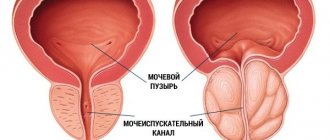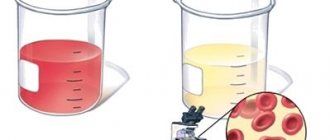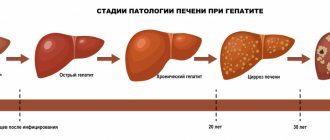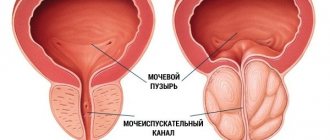Causes and symptoms of the disease
Gallstone disease can cause the development of cholecystopancreatitis.
Inflammation of the gallbladder is provoked by the following reasons:
- disruption of the movement of bile along the bile ducts;
- bile stagnation;
- irregularity in eating;
- the presence of parasites in the body;
- entry of gland juice into the bile ducts.
Pancreatitis occurs if there are reasons such as:
- eating fatty foods;
- alcohol consumption;
- taking medications without a doctor's prescription;
- insufficient protein intake;
- disruption of vascular blood supply;
- organ pathology (tumor, scars).
The development of chronic cholecystopancreatitis is influenced by the following factors:
- increased acidity;
- cholelithiasis;
- peptic ulcer pathology of the stomach;
- cancerous tumors of the gland;
- tumor inclusions of the gastrointestinal tract.
Pancreatitis develops against the background of chronic gallbladder disease and vice versa. In the acute stage of the disease, a decrease in body weight, stool instability, bloating, and the presence of fatty inclusions in the stool are observed.
A rash occurs on the skin, and the skin around the navel appears blue. Painful palpation of the pancreas area and the presence of a compaction. Necrosis of the abdominal muscles is common.
Lack of food enzymes in the chronic course of the disease leads to loose, whitish stools and the presence of undigested food fibers in the stool. There is a blockage of the duodenal duct.
Work of the organ
The gallbladder is an anatomical part of the liver. This sac-like organ is necessary for storing bile synthesized by liver cells and removing fluid into the small intestine during digestion. The release of bile into the cavity of the duodenum promotes the absorption of fatty foods and improved absorption of nutrients. There is a constant accumulation of secretion in the organ, leading to an increase in the viscosity of the fluid. After food enters the intestines, hormones stimulate the relaxation of special valves and the release of bile into the gastrointestinal tract through special ducts.
Other organ functions:
- Maintaining metabolism.
- Improving small intestinal motility.
- Release of excess cholesterol and bilirubin from the body.
- Activation of enzymes necessary for the absorption of protein foods.
The gallbladder is often subject to pathological influences. Disruption of the muscular lining of the organ can impede the secretion of bile - this process not only harms digestion, but also contributes to the formation of stones that can subsequently completely block the bile ducts and damage the internal lining of the gallbladder. Normally, the organ does not contain microflora, but with diseases and anatomical defects, pathogenic and conditionally pathogenic microorganisms from the intestine may penetrate into the gallbladder.
Diagnosis of the disease
An abdominal ultrasound is the best way to diagnose the disease.
Diagnostic methods can be: direct, indirect, stool examination for elastase (a breakdown enzyme), a special respiratory test, detection of hormonal disorders, analysis for steatorrhea (fatty and oily stools). Additionally, the following examinations are performed:
- biochemical analysis of collected blood;
- analysis for the presence of sugar in the blood;
- ultrasound examination of the abdominal cavity;
- magnetic resonance imaging;
- proteinogram.
Introduction
Chronic pancreatitis (CP) is an inflammatory, continuously persistent disease of the pancreas (PG), often associated with pain, which is characterized by the development of irreversible morphological changes in the parenchyma and ductal system of the pancreas and the progressive destruction of organ tissue, leading to disruption of exocrine and endocrine functions [1 , 2].
Several risk factors have been established and/or suspected, but in a small proportion of patients the disease is idiopathic. Clinically, the early phase of the disease is characterized by pain or recurrent exacerbations of pancreatitis and the development of complications, while in the later stages of the disease, symptoms are caused by the appearance of exocrine and/or endocrine insufficiency. Chronic pancreatitis in the late stages is considered a risk factor for the development of pancreatic cancer [3–5], and therefore treatment of CP with conservative, surgical, endoscopic methods, or a combination thereof, can be considered as a putative measure for the prevention of carcinogenesis in the pancreas.
Despite numerous attempts, an ideal system for the etiological classification of CP has not yet been created. An emphasis on the etiology of CP is necessary because it provides an attempt at etiotropic treatment (for example, obstructive pancreatitis) or a more accentuated pathogenetic one when the first option is impossible (for example, treatment with steroids for autoimmune pancreatitis). One of the latest options for systematizing the many etiological factors of CP is the M-ANNHEIM classification of CP risk factors (Multiple, Alcohol, Nicotine, Nutrition, Heredity, Efferent pancreatic duct factors, Immunological factors, Miscellaneous and Metabolic factors) [6].
Alcohol abuse. Alcohol is responsible for 60–70% of cases of CP in the Western world. The dose of daily alcohol consumption at which the risk of developing CP increases has not been established, but according to some estimates, it may be 60–80 ml/day (pure ethanol). Gender, genetic and other factors may play a major role, and as a result, the term “alcoholic pancreatitis” does not necessarily imply chronic alcoholism or the consequences of alcohol abuse. Smoking increases the risk of development and progression of CP [2].
Smoking. The odds ratio for developing CP for smokers compared with non-smokers ranges from 7.8–17.3; The risk increases with the number of cigarettes smoked and the length of smoking. Thus, smoking should be considered an independent risk factor for the development of CP [7, 8].
Nutritional factors. The relationship between protein-energy malnutrition, hypertriglyceridemia, other hyperlipidemias and CP is ambiguous [2].
Hereditary factors. Inherited factors are believed to play a role in hereditary pancreatitis, familial pancreatitis, idiopathic pancreatitis with early and late manifestations, and tropical pancreatitis. Mutations in the coding part of the cationic trypsinogen gene lead to the development of hereditary pancreatitis [9]. In affected individuals, symptoms usually begin before the age of 20 years, and the risk of developing pancreatic adenocarcinoma is markedly increased. Mutations in the coding portion of the cystic fibrosis transmembrane conductance regulatory (CFTR) [10] and trypsin inhibitor (PSTI or SPINK1) [11] gene have been identified in patients with idiopathic CP.
Factors affecting the outflow of pancreatic secretions. Conditions associated with the development of obstructive CP are trauma, the presence of stones, false cysts and tumors. It is not precisely established whether CP occurs against the background of a split pancreas (pancreas divisum) and dysfunction of the sphincter of Oddi [2].
Immunological factors. Autoimmune pancreatitis (AIP) can occur alone or in combination with Sjögren's syndrome, inflammatory bowel disease, and many other autoimmune disorders. Clinically relevant serum findings for the diagnosis of AIP include hypergammaglobulinemia, elevated levels of immunoglobulin G (IgG), especially IgG4, and the presence of certain autoantibodies (antinuclear antibodies, anti-lactoferrin antibodies, anti-carbonic anhydrase type II antibodies, and anti-smooth muscle antibodies) [12]. It is extremely important to identify the etiological form of AIP in patients, since this form of the disease can be treated with corticosteroids.
Other and rare metabolic factors. Chronic renal failure [13] and hyperparathyroidism [14] are established causes of CP, while the exact role of drugs and toxic substances remains completely unproven [2].
Thus, a detailed history is of paramount importance, since its analysis can identify the etiological factor. Particular attention should be paid to occupation, potential exposure to toxic substances, diet, alcohol consumption and smoking. It is appropriate to use validated measures to detect alcohol abuse. Kidney disease and hyperparathyroidism should be considered in the differential diagnosis, and a history of autoimmune disease may indicate the presence of AIP. A thorough family history should be collected, and if a hereditary disease is suspected, genetic counseling is required.
Chronic cholecystopancreatitis, treatment methods
A combination of direct and indirect examinations allows us to create a picture of the disease, its stage and the severity of the patient’s condition. Based on the results of all the results, treatment is prescribed, which continues for a long time. When treating, adhere to the following principles:
- Restoring normal internal and external functioning of the pancreas.
- Relieving inflammatory processes in the gland.
- Elimination of the consequences of complications.
- Normalization of the patient’s life, development of proper diet and rest.
This video will tell you about chronic cholecystitis and cholelithiasis:
https://www.youtube.com/watch?v=C9JmXx1zbyg
Diagnostics
Blood analysis. The results of a blood sample during an exacerbation often reveal an increase in ESR, eosinophilia, neutrophilic leukocytosis, and a shift to the left in the leukocyte formula. Complicated forms are accompanied by an increase in blood levels of cholesterol, bilirubin, and transaminases.
Duodenal sounding. The severity of the inflammatory process is characterized by the results of analyzes of bile obtained from the body during duodenal intubation. As a rule, in this case, the bile is cloudy, it contains flakes, a significant admixture of mucus, cellular detritus, and columnar epithelium.
Bacteriological research. All portions of bile are analyzed. This makes it possible to determine the etiology of the inflammatory process and the susceptibility of the body's microflora to antibiotics.
Ultrasound and X-ray. X-ray examination can detect various signs of morphological or functional changes in the gallbladder or other digestive organs. Contrast examination of the gallbladder (cholangiography, cholecystography) makes it possible to identify disturbances in concentration ability, impaired motor function, and deformation.
Radioisotope method. Studying the state of the biliary tract and analyzing the absorption and excretion function of the liver can be carried out using the radioisotope method. More accurate diagnosis is achieved in combination with fractional multicomponent duodenal intubation. A more detailed study of the gallbladder and ducts is possible using the radio-X-ray chromodiagnostic method. Using ultrasound, it is possible to establish the absence of stones, as well as assess the contractility and condition of the gallbladder wall (a sign of chronic cholecystitis is its thickening by 4 mm or more).
Treatment methods
Mineral water will help relieve the acute form of chronic cholecystopancreatitis.
To relieve the acute form of chronic cholecystopancreatitis, it is prescribed to drink hydrocarbonate-chloride mineral water, 250 g five times a day.
A diet without fatty, spicy foods, soda and sour apples, smoked meats, marinades, strong tea and coffee is recommended. Meals should be fractional and gentle on inflamed organs. Drug treatment is as follows:
- To block pain and improve the movement of bile and pancreatic juice, antispasmodics (papaverine, duspatalin) and analgesics (injectable analgin and tramadol) are used.
- To ensure normal digestion, drugs are used - enzymes (Creon, Pancreatin), which are taken before meals.
- To reduce the production of gland secretions, medications such as omeprazole and pantoprazole are allowed.
- Antibacterial agents are used (metronidazole, azithromycin).
- To restore the intestinal microflora, they are prescribed (bifiform, hilak).
Physiotherapy is prescribed:
- laser therapy;
- low-intensity UHF procedure;
- high frequency UHF.
Procedures to relieve pain:
Forms of the disease
Doctors classify chronic cholecystitis based on the cause of inflammation and the nature of the disease. There is also a classification based on the severity of symptoms.
Basic forms:
- Chronic calculous cholecystitis is the most common variant of the disease, resulting from blockage of the excretory ducts of the organ with stones. Characterized by severe symptoms during exacerbations. The inflammatory process can spread to adjacent anatomical structures, including the diaphragm and pleura.
- Chronic noncalculous cholecystitis is a rarer form of the disorder, often diagnosed in patients with severe illness. In this case, the inflammatory process occurs due to injury, surgery, severe infection and other reasons not related to the formation of stones. If not treated in a timely manner, non-calculous cholecystitis can cause the patient's death.
The danger of chronic inflammation is due to the erased symptoms. Patients pay attention to unpleasant sensations only during exacerbations, as a result of which the disease gradually progresses and causes complications.
Folk remedies and prevention
Flaxseed oil is an excellent folk remedy for cholecystopancreatitis.
With this disease, painful inflammation of both organs is combined, so compatibility of herbal preparations is necessary. The following treatment recipes are common in folk medicine:
- Aqueous tincture of wormwood and yarrow herbs. Take a teaspoon of each part, brew it in a glass of boiling water, let it brew for half an hour, drink 100 g 3-4 times during the day.
- Herbal infusion of wormwood, peppermint, St. John's wort. Take a teaspoon of each ingredient, pour 400 ml of boiling water, leave for 20 minutes, take on an empty stomach 2 times in the morning and one glass in the evening.
- Herbal infusion of herbs: chamomile, peppermint, tricolor violet, St. John's wort and linden blossom. Take 1/2 tablespoon of all types of herbs, brew 400 g of boiling water, let stand for 30 minutes and drink a glass before meals three times a day.
- Use flaxseed oil for treatment.
- Drink castor oil cocktail and any fruit juice. Promotes natural cleansing of the gallbladder.
- Including herbs and spices in food, for example: garlic, basil, nutmeg, turmeric, ginger.
- Drink a lot of water at least 2 liters per day, you can drink warm water with lemon.
- Drink herbal teas with calendula, chamomile, and dandelion every day.
- Monitor your cholesterol levels and avoid eating foods that increase cholesterol.
- Include in your diet fruits and vegetables, foods rich in vitamin C such as fresh cabbage, grapefruit, oranges.
Prevention consists of the usual recommendations: stop smoking, consume excessive alcohol, follow a diet, and get plenty of rest. Avoid stress, overwork, exercise, move more, encouraging bile not to stagnate.







